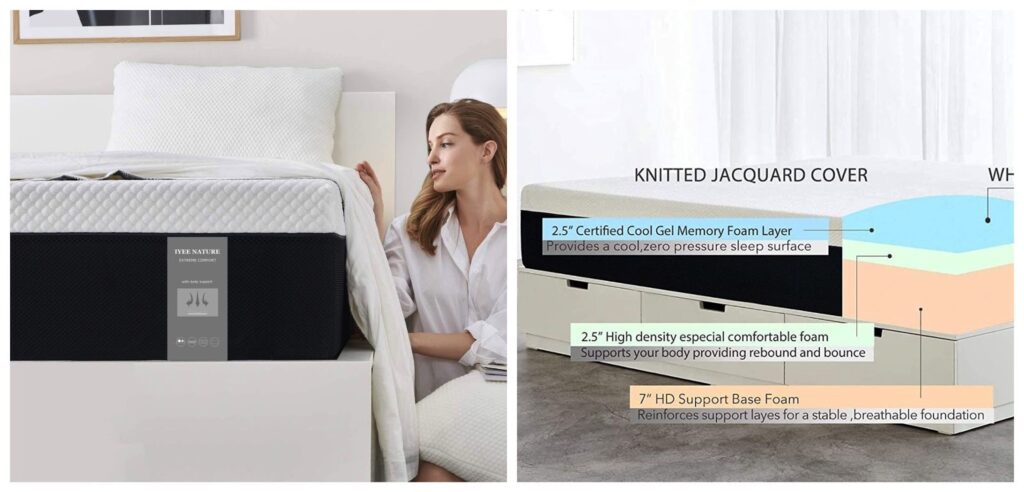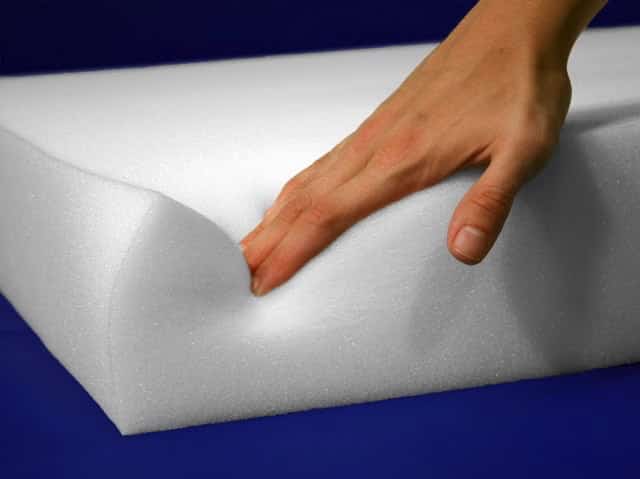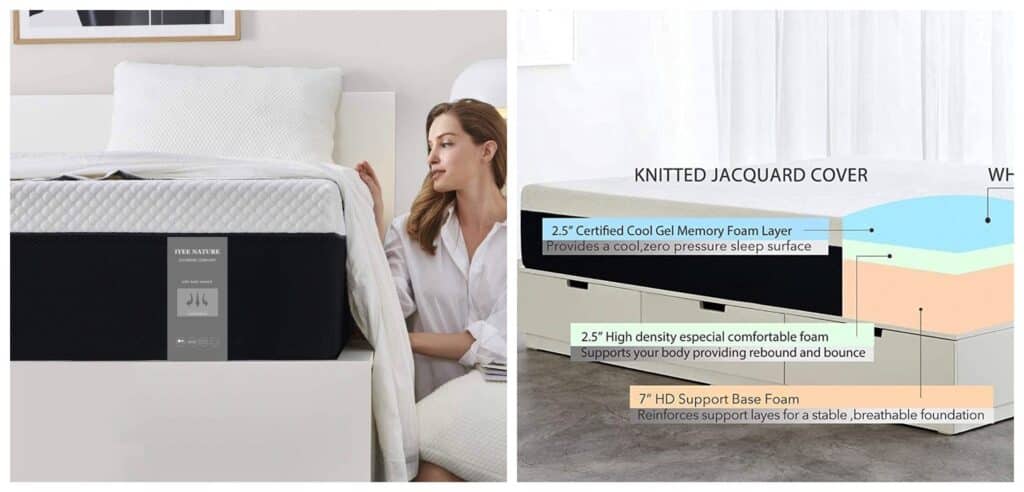Singling out the best mattress is impossible because each person has their own unique preferences when it comes to mattress comfort. Every type of mattress has distinctive benefits and limitations to consider when shopping for the right bed. Orthopedic mattresses, in particular, are popular among those struggling with a variety of medical conditions. While some orthopedic mattresses incorporate springs, others offer spring-free support for different areas of the body. In this article, we’ll discuss orthopedic mattresses without springs and how to select the right one for your needs.
Different types of orthopedic mattresses without springs include memory foam, latex, and gel-infused mattresses. Orthopedic memory foam mattresses are more affordable than the others, latex mattresses are firmer, more durable, and regulate temperature well, and gel-infused mattresses are both affordable and designed for temperature regulation.
Do All Orthopedic Mattresses Have Springs?
Many people think that mattresses without springs cannot be firm enough to offer adequate support for the body. The truth is that you can easily find dozens of firm mattresses that do not have springs incorporated in their designs.
Not all orthopedic mattresses have springs. Orthopedic mattresses made of memory foam, latex, polyfoam, gel-infused foam, and natural fillings are more common than innerspring or pocket spring mattresses. Spring-less orthopedic mattresses can provide targeted support and last for a long time.
To achieve the desired firmness, springless mattresses are made from denser foam, latex, or other materials. Read our article about orthopedic versus spring mattresses to learn more about the differences between these two types of mattresses.
Orthopedic mattresses are designed to provide excellent support for maintaining neutral spine alignment. They can also help with pain and pressure point relief for different parts of the body and don’t necessarily have to include springs to do so. As long as you select a spring-free orthopedic mattress made from suitable materials, and with the right density like this one, you will have the benefit of an orthopedic mattress without springs.

What Are the Benefits of Using Orthopedic Mattresses Without Metal Springs?
Orthopedic mattresses vary in their construction, materials, density, thickness, firmness, and other features. As our preferences and needs differ, there is no one-size-fits-all orthopedic mattress solution.
Spring-less orthopedic mattresses can relieve back pain, provide joint support, alleviate sleeplessness, are durable, and last longer. Doctors recommend spring-free mattresses for their superior construction, spinal support, and pressure relief for sensitive joints.
Before choosing the right spring-free orthopedic mattress, examine the benefits of each specific mattress carefully by reading our article that explains the 7 benefits of orthopedic mattresses.
Benefit 1. Reduced Pressure on Sensitive Joints
According to this article from the Centers for Disease Control and Prevention, 25% of adults in the United States suffer from severe joint pain caused by arthritis. While there is not much scientific evidence of a correlation between a mattress type and joint pain, several medical studies suggest that using the right type of spring-free orthopedic mattress can significantly improve the overall sleep quality for those experiencing arthritic pain.
This article by Medical News Today states that softer orthopedic mattresses without springs like this one, help to reduce joint pressure and reduce pain in these areas. In fact, innerspring orthopedic mattresses would not be soft enough to provide comfortable support for individuals with arthritis. While some innerspring mattresses include a comfort layer on top of the metal springs, they are still not the best option for those struggling with joint stiffness and pain.
Benefit 2. Relief for Those with a Bad Back
Back pain is one of the most common causes of poor sleep quality. Although there is some controversy regarding mattress types and their relevance for reducing back pain, various reviews show that medium-firm orthopedic mattresses are the best choice for relieving chronic back and joint pain. This is discussed in more detail in our article on choosing an orthopedic mattress for sciatica pain.
According to this systematic review of controlled trials, medium-firm mattresses boost sleep quality by promoting optimal spine alignment and relieving symptoms in patients with a bad back. The results of another systematic review conducted in 2016 suggest that chronic lower back pain can be reduced by using a medium-firm orthopedic mattress. Although that study failed to reach statistical significance and it is not possible to draw robust conclusions, participant responses still highlight the benefits of a medium-firm orthopedic mattress like this, without springs, for individuals with a bad back.
Benefit 3. Proper Spinal Alignment and Pain Relief
Keeping your spine properly aligned while sleeping is key to reducing pain in different parts of the body. This is why you should always try to keep your spine in neutral alignment. While some people think that it is all about choosing the correct sleeping position, this is not always the case.
Neutral spine alignment describes the position of your spine where all three curves—cervical (neck), thoracic (rib cage), and lumbar (pelvis) —are in proper alignment. Neutral spine alignment can easily be achieved by using a spring-free orthopedic mattress like this, with medium firmness.
According to this article from Thrive Chiropractic Health Center, innerspring mattresses have a shorter useful lifespan, and compromised mattresses significantly affect spinal alignment. In addition, mattresses with springs typically do not provide enough support for the body and are either too firm or too soft.
The ideal firmness of an orthopedic mattress should be right in the middle: not too soft and not too firm. This prevents sinkage but ensures that the surface is still soft enough to relieve pain and to feel comfortable as we explain in our orthopedic mattress shopping guide.
Benefit 4. Individual Support for Couples
Finding the right orthopedic mattress to share with a partner is crucial to ensure both sleepers get good quality sleep. Unfortunately, determining a mattress type that suits the needs and preferences of both sleepers can be challenging. Our article about using an orthopedic mattress on an adjustable bed discusses how separately articulating bed frames like these, can offer customizable support for people who share a bed.
One key is to identify a mattress that isolates motion to reduce sleep disturbances. While innerspring orthopedic mattresses are favored by some individuals, they are not very good at isolating motion. Also, these mattresses often do not provide enough support and comfort, especially when two sleepers share the same bed.
On the other hand, memory foam and latex mattresses offer ideal motion isolation, so spring-free orthopedic mattresses are ideal for couples sharing the same bed. To choose the right firmness, take into account both individuals’ preferences and specific health conditions. Read our article about memory foam versus smart grid foam to learn more about their motion isolating properties.
Benefit 5. Superb Temperature Regulation for Overweight Sleepers
While good temperature regulation is a huge benefit for anyone, this issue is especially important for overweight sleepers. According to this 2018 research paper on PubMed, thermoregulation is a complicated process in obese individuals. Since overweight people often have trouble maintaining and controlling body temperature, sleeping on a breathable mattress like this is essential.
Although innerspring mattresses sometimes feature a gel-infused layer to improve temperature control on the surface, the materials beneath are not always breathable enough to provide the required comfort. On the other hand, the right spring-free orthopedic mattress made of latex, cotton, wool, or gel-infused foam, can offer excellent support, consistent breathability, and superb temperature regulation for heavy individuals. Read our article about choosing an orthopedic mattress for heavier people for tips on selecting the right mattress.
Benefit 6. Ease of Getting In and Out of Bed for Those with Mobility Issues
When choosing a mattress for individuals with mobility issues or other disabilities, you should always check the mattress’ degree of motion transfer. While innerspring orthopedic mattresses are still popular, they are not suitable for those who have trouble getting in and out of bed because metal springs make the mattress too bouncy.
On the other hand, a spring-less orthopedic mattress like this offers less motion transfer and is ideal for those with specific mobility issues. Besides, these mattresses are suitable for adjustable beds, making them even more convenient for individuals with limited mobility and strength.
Benefit 7. Greater Durability and Longer Useful Lifespan
Last but not least, spring-free mattresses perform well in durability tests and often get a durability rating of fair, good, or even very good. In this article, Sleep Foundation states that the average useful lifespan of an innerspring mattress is 5.5 – 6.5 years. In comparison, spring-free mattresses have an average useful lifespan of 6-10 years.
Studies have shown that memory foam and hybrid mattresses last longer than innerspring mattresses. Latex mattresses last even longer and are considered among the most durable options as discussed in our article about using a mattress topper to protect and prolong the lifespan of a mattress.
Durability is especially important for heavy people. As more weight and pressure is put on the mattress during sleep, the right materials are necessary to ensure that the mattress won’t need replacing prematurely. Investing in a natural latex orthopedic mattress like this, without metal springs would be the ideal choice.
You might also be interested in learning why orthopedic mattresses work and reading a quick comparison between orthopedic mattresses vs. latex mattresses to find out what the real differences are. Be sure to take a look at both of those articles to find out more.
Types of Orthopedic Mattresses Without Springs
As innerspring mattresses have become commonplace around the world, there is a misconception that these mattresses are more comfortable and beneficial than those without metal springs. The fact that orthopedic mattresses with springs are widely used does not necessarily mean that they are better.
Types of orthopedic mattresses without springs include memory foam, latex, and polyfoam mattresses. Memory foam mattresses are affordable, isolate motion, and relieve pressure, while latex mattresses are made of natural materials and provide medium-firm support, and polyfoam mattresses provide superb comfort.
In the 21st century, there are plenty of other options when it comes to orthopedic mattresses, and many spring-free alternatives perform much better than those with traditional springs and coils.
Memory Foam
Memory foam orthopedic mattresses are among the most popular options. The primary reason is that these mattresses can be both affordable and exceptionally comfortable. The price of an orthopedic memory foam mattress ranges from $200 to $2,000 and above.
Memory foam mattresses are also available in a variety of thicknesses and firmnesses. Softer memory foam mattresses are ideal for individuals with joint pain, while firmer options benefit individuals struggling with back pain. Memory foam mattresses also mold to the body and provide excellent motion isolation. This makes them ideal for those who share a bed with a partner.
Memory foam mattresses have some drawbacks too. Lower quality memory foam mattresses often release toxic chemicals that can be harmful to your health. Such mattresses also have a distinct odor that does not really disappear. This is why you should always look for high-quality memory foam mattresses that come with safety certifications. Read our article on how to reduce mattress topper smells which has helpful tips that you can apply to memory foam mattresses too.
Another disadvantage of memory foam mattresses is that they are sometimes too soft and people can feel that they are sinking into the mattress. If you do not really enjoy being “in” the mattress rather than “on” its surface then it is especially important to select the right memory foam, so be sure to opt for a medium or high-density memory foam mattress like this.
Latex Foam
Latex is a popular material for orthopedic mattresses with no metal springs. Since latex mattresses are typically made of natural latex, they are more expensive than memory foam options. An average price of a latex orthopedic mattress varies from $350 to $5,000.
The pros of a latex mattress include exceptional comfort and superb pain relief for different areas of the body. In addition, as latex mattresses are typically made of natural, high-quality materials, they are among the best choices for individuals struggling with back pain or joint stiffness. Latex mattresses are firm enough to provide adequate support for the body and promote neutral spine alignment. This latex mattress is breathable and offers excellent temperature regulation, especially for heavier individuals.
Latex is naturally mold-resistant, so you do not have to worry about mold or dust mites. That makes latex an ideal option for those allergic to dust or mold.
The primary disadvantage of a latex mattress is its cost. Natural latex mattresses are more expensive than alternative options and may not always be affordable for individuals who need to purchase a mattress on a tight budget. However, latex mattresses are durable and last longer which can make investing the extra money worth it in the long run.
Another drawback of a latex mattress is that it can be very heavy and can’t be moved around easily. While moving a latex mattress requires more effort, a latex mattress’ quality and comfort can really make up for this bulkiness.
Polyfoam Mattress
While polyfoam orthopedic mattresses are less popular, they can also be an effective alternative to traditional innerspring orthopedic mattresses. Polyfoam mattresses are made of polyurethane. Prices range from $50 to $150 depending on the size, thickness, and density. Read our article about orthopedic mattress sizes to learn more about the various options to choose from.
The primary advantage of polyfoam mattresses is that they are cheap but still serve their purpose. As these mattresses come in various thickness and density options, you can easily choose soft, medium-firm, or firm based on your preferences and needs.
While polyfoam mattresses are somewhat responsive, they are not as comfy as those made of memory foam or latex. The main drawback of polyfoam mattresses is that they are not as good at providing enough support to promote proper spine alignment and reduce back pain. However, they are soft enough to relieve joint pain. Still, investing in memory foam or latex orthopedic mattress would be a better choice, especially if you have physical health or mobility issues.

Here we have a summary of orthopedic mattresses without springs and why they would be necessary:
| Reason for Purchasing an Orthopedic Mattress: | Would a Spring-Free Mattress Be Better for You? | Why? | What Type of Spring-Free Orthopedic Mattress Would Be Best? | Example from Amazon |
| Joint Pain | Yes | Mattresses without springs offer better pressure relief for patients with joint pain. | Soft or medium-firm memory foam mattress | Sensei Medium Firm Orthopedic Mattress |
| Insomnia | Possibly | You cannot really tell which mattress type would work better until you determine the reason for insomnia. | It would depend on your personal preference and needs. | |
| Arthritis | Yes | Individuals with arthritis require enough softness and support to relieve pressure on sensitive joints. | Soft or medium-firm memory foam mattress | Nectar Queen Medium-Firm Gel Memory Foam |
| Bad Back | Yes | An orthopedic mattress should provide enough support to promote neutral spine alignment for those with a bad back. | Medium-firm latex mattress | Continental Sleep Firm Orthopedic Mattress |
| Obesity | Yes | Spring-free orthopedic mattresses are more durable, longer-lasting, and breathable. | Breathable memory foam mattress with a gel-infused comfort layer | LUCID Gel Memory Foam Mattress – Medium Firmness |
| Mobility Issues | Yes | Orthopedic mattresses with no springs are suitable for adjustable beds that benefit disabled people and those with mobility issues. | Mattress with firm edge support and suitable height | Swiss Ortho Firm Mattress |
| Temperature Control | Yes | Spring-free orthopedic mattresses offer consistent breathability and enhanced temperature regulation. | Gel-infused orthopedic mattresses | DynastyMattress Cool Breeze HD Gel Memory Foam Mattress |
Key Takeaways
Finding the Right Orthopedic Mattress Without Springs
When shopping for a spring-free orthopedic mattress, considering your unique needs and preferences is paramount. Orthopedic mattresses without springs come in varieties like memory foam, latex, and gel-infused, each with their distinctive benefits catering to different needs such as back pain relief, joint support, and temperature regulation.
Benefits of Spring-free Orthopedic Mattresses
Orthopedic mattresses without springs offer various benefits including reduced pressure on sensitive joints, relief for back pain, proper spinal alignment, individual support for couples, excellent temperature regulation especially for overweight sleepers, ease of getting in and out of bed for those with mobility issues, and greater durability with a longer useful lifespan.
Types of Spring-free Orthopedic Mattresses
Memory foam orthopedic mattresses are popular due to their affordability and comfort. They excel in motion isolation, making them ideal for couples. Latex orthopedic mattresses, although more expensive, provide excellent support, are naturally allergen-free, and offer a firm yet comfortable sleep surface. Polyfoam mattresses are the least expensive but may lack in providing adequate spinal support compared to memory foam or latex mattresses.
Considerations for Specific Needs
Your specific needs play a crucial role in determining the right spring-free orthopedic mattress. For instance, individuals with back pain might find medium-firm memory foam or latex mattresses more suitable, while those with joint pain might benefit from the softness of a polyfoam mattress. Evaluating the firmness, durability, and the material of the mattress in correlation with your personal needs and budget is essential in making an informed decision.
Investment in Quality for Long-term Benefits
Investing in a high-quality spring-free orthopedic mattress may have a higher upfront cost but can offer significant benefits in the long run including better sleep quality, pain relief, and lesser need for replacements due to their durable construction. Especially, natural latex mattresses, while being on the pricier side, are known for their longevity and consistent support over the years.

